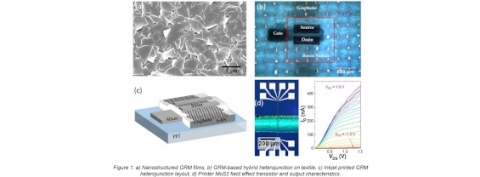Seminario del Prof. Felice Torrisi

Seminario del Prof. Felice Torrisi (Molecular Science Research Hub, Imperial College London, UK)
Luogo: Aula Seminari del Dipartimento SBAI - Pal. RM004
Giorno: 18/07/2022 ore 16.30
Wearable electronics play a primary technology to enable remote healthcare provision, which is highly important in a post-pandemic society.
Graphene and related 2D materials (GRMs) hold a great potential for wearable electronics for their novel electrical and optical properties. In particular low temperature production and deposition of nanostructured GRM films (fig.1a) from GRM-based solutions is extremely attractive for printed flexible and wearable electronics. [1, 2] GRM-based inks enable a large range of printed device and integration options, such as digital, lithographic printing and roll-to-roll coating, which are ideal to deposit nanostructured GRM films. Liquid Phase Exfoliation (LPE) of bulk precursor layered materials (such as graphite, MoS2 crystals, etc.) is a scalable approach ideally suited to produce inks
However, the low-yield of the LPE process, the absence of deposition parameters and the undetermined transport properties of the GRMs have limited the full scale applications of these materials in printed and wearable electronics. I will give a brief overview on the development of high-yield, cost-effective and large-scale production techniques for GRM-based inks, and the portfolio of reproducible deposition processes enabling GRM-based printable devices on flexible and textile substrates (fig.1b).[3] Then I will show how careful tuning of the flakes-substrate surface interaction and GRM deposition process enables hybrid heterojunctions from 2D materials (fig.1c), achieving mobility > 100 cm2 V-1 s -1 at room temperature.
[4] Finally, I will demonstrate how unveiling of the electronic transport in printed networks of 2D materials paves the way to high-performance inkjet printed integrated circuits of 2D material semiconductors, such as MoS2 [5] (fig.1d).
